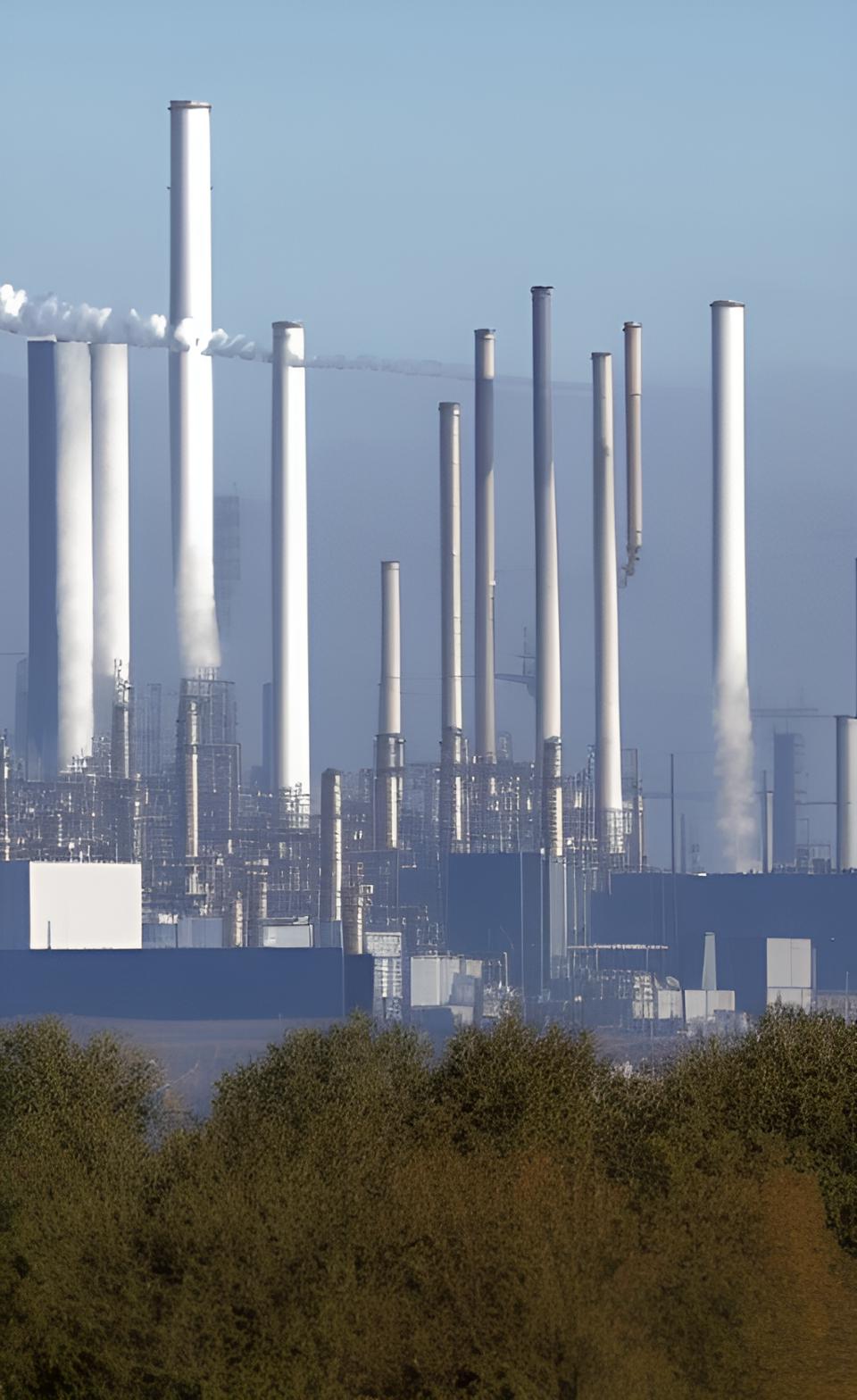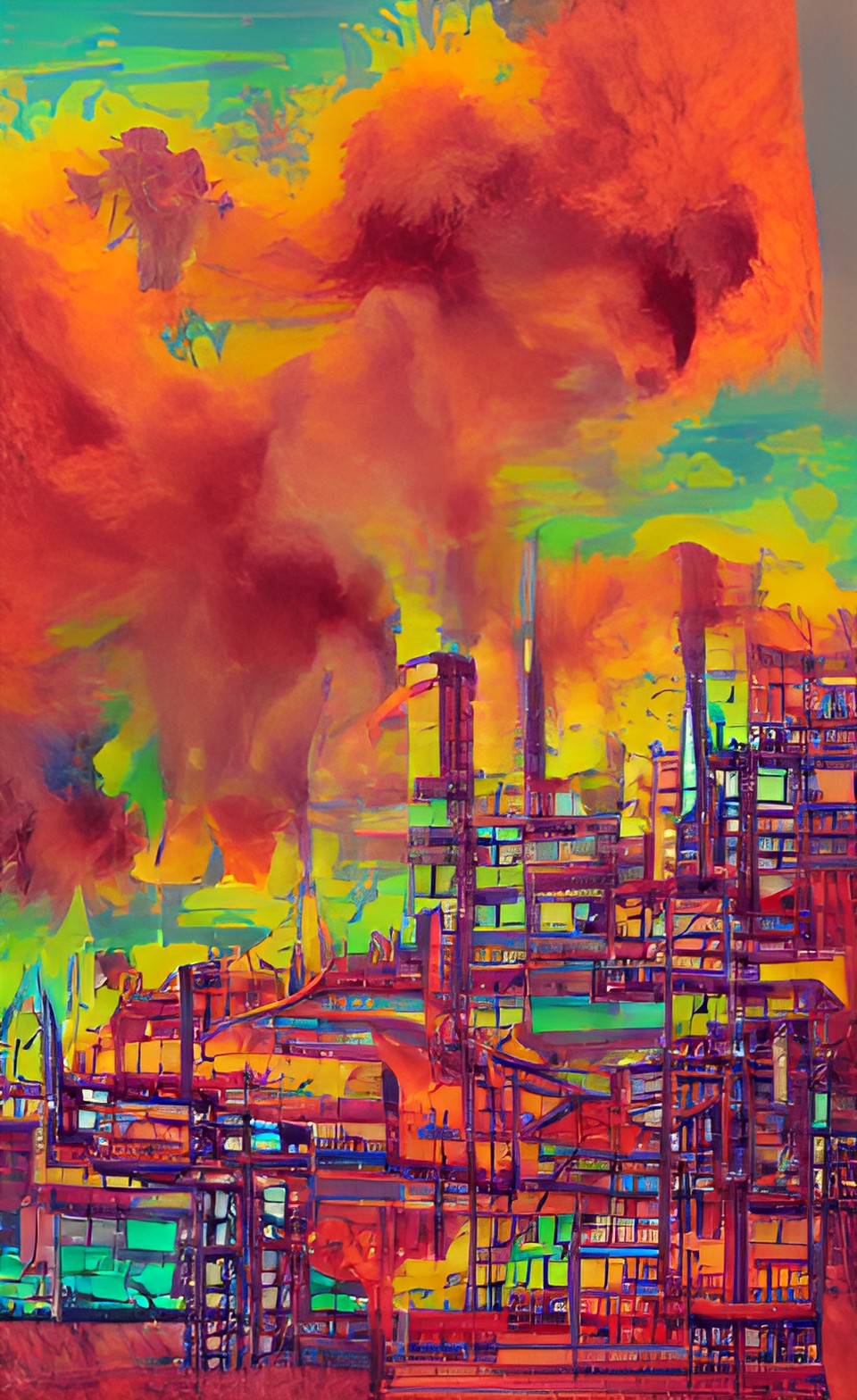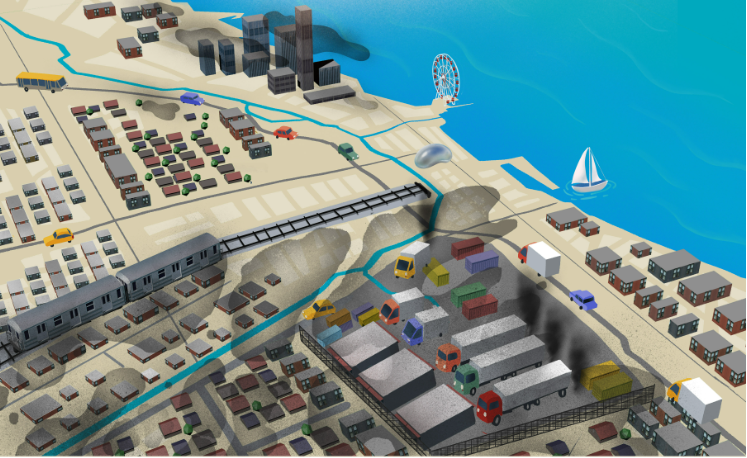- Air Homepage
- Alberta Air Quality
- Air Quality Dispersion Modelling
Keeping our air clean with air quality dispersion modelling
Scientists use air quality dispersion modelling to predict pollution on behalf of industry and for regulators to make decisions. Take smoke from a factory - these models tell you where it goes and how much it will be in the air.
It's a Science: Mastering Dispersion Modelling and Western Canadian Guidelines - Who decides if the invisible plumes of smoke and gas released by industrial facilities are safe for your community? Get to know the science behind air quality dispersion modelling, where advanced computer simulations become the ultimate tool to make sure the air we breathe stays clean, healthy, and compliant!
 Safeguarding community health
Safeguarding community healthClean air is maintained by doing this! In Canada, different provinces have guidelines for these scientists. Some parts of them are like checklists, others explain how to use relevant computer programs.
What's the ultimate goal? Everyone deserves healthy air!
What's the point? People who care about clean air and how science helps us keep it would be interested. Here are some examples:
- People who live near factories,
- Concerned parents,
- Anyone interested in how scientists solve environmental problems,
- People who work in fields like environmental science or urban planning
Here are protocols for each of the four western provinces in Canada to help modellers make air quality assessments and to help their citizens live a healthy life. We'll explore how each of them instructs us to handle each part of an air quality dispersion modelling project.
Workplace safety and air contamination: IDLH, GLE, LFL
IDLH (Immediately Dangerous to Life or Health): Concentrations of airborne contaminants (like hydrogen sulphide) that pose an immediate threat to life or cause irreversible health effects. These values determine mandatory protective gear and emergency response measures.
Guidelines Exposure Limits (GLE) are recommended exposure limits for various pollutants for durations longer than IDLH. Air quality management strategies are governed by regulations.
Air quality management strategies are governed by regulations. Understanding lower flammability limits (LFL) is crucial to preventing fires and explosions in flammable gas environments.
How about if you work inside? Pollutants from the outside can get into buildings through ventilation systems, windows, and doors. The extent of this impact depends on building design, ventilation rates, and outdoor pollutants (e.g., particulates).
Air Quality Dispersion Modelling - General Description & Prefaces
BC (British Columbia)
Dispersion models predict how pollution travels in the air. Think about smoke coming out of a factory chimney. Air quality dispersion models can predict where smoke will go and how much will remain in the air.
Here's why it's helpful:
- Locate air pollution culprits: The model can pinpoint which factories or areas are causing the most pollution.
- Cities can use models to see if a new factory will cause air quality problems or if it's safe to build houses near one.
- Consider different scenarios: Imagine a city considering a new highway. the air quality impact of this development can be predicted with a model.
We need these models to inform us of ways to keep our air clean, but they're not perfect. These models may not be 100% accurate, just like a regular calculator.
Make sure the models are used correctly and that you feed them good information when you use them. Keeping British Columbia's air clean is like a puzzle. Scientists can use the provincial guideline document as a guide to solve that puzzle. Here's what it says:
- This BC guideline helps scientists choose the right tools (models) to understand air pollution.
- The guide also explains how to use these tools correctly to get an accurate picture of air pollution.
What kind of people can use it? Experts who already know a lot about air and these special tools. Scientists use the general directions provided in this document to keep British Columbia's air clean and healthy!
AB (Alberta)
Let's say a factory wants to build in your neighborhood. How do scientists predict if the factory's smokestacks will pollute the air? Here's what you need to know:
- To predict how much smoke, gases or particulates will be in the air around the factory, scientists use a fancy computer program.
- Air pollution limits: There's a limit on how much pollution you can have. This program makes sure the factory doesn't go over those limits.
- Here's the latest update (2021) to the air pollution prediction program.
 An air dispersion assessment is part of an EIA
An air dispersion assessment is part of an EIAKeeping Alberta's air clean and healthy might seem complicated, but it's all about keeping everyone healthy!
The Alberta Environment and Protected Areas (AEPA) Air Quality Model Guideline is designed for regulatory purposes under the Environmental Protection and Enhancement Act (EPEA). It makes it easier to use dispersion models for different applications. Air quality modelling, also known simply as dispersion modeling, is outlined in the Alberta guideline.
For more information on air quality modelling, users are encouraged to consult user guides and reference materials published by the makers of each model. To make sure the best tools are used for predicting air quality, the provincial guideline is reviewed regularly. You can find more info on dispersion models on Alberta Environment and Protected Areas' (AEPA's) and the (United States) EPA's websites.
 Assessing new developments' air quality
Assessing new developments' air qualitySK (Saskatchewan)
Clean air is like an invisible blanket. We need to keep this blanket healthy so everyone can breathe.
Scientists use special tools (air quality models) to track how much pollution is in the air. They check if factories and other sources are putting too much pollution in the air.
Keeping it clean: By using these models, we can make sure the air stays healthy for everyone.
The text in the SK guideline explains how to use these air quality models properly, how to keep our air clean. Let's say keeping the air clean in Saskatchewan is like building a sandcastle. Building a castle requires strong sand, so make sure the air isn't too polluted.
The guide is like a set of instructions for building the best sandcastle (clean air). Here's what you need to know:
- To predict air pollution, scientists use fancy calculators (models).
- As with sandcastles, there are limits on how much pollution is allowed. Here's how to use the models to keep the air clean.
- Keeping it up to date: Scientists regularly check and update these tools to make sure they're accurate.
Scientists use this guide to keep Saskatchewan's air clean and healthy!
MB (Manitoba)
Picture a factory with smokestacks spewing out pollution. The government has rules to keep the air clean:
- Pollution limits are like speed limits. Smoke can't be too much in factories.
- Government checks the stacks to make sure they're following the rules.
- Scientists use fancy calculators to predict where smoke and other emissions will go and how much will be in the air. In this way, smoke doesn't pollute the air.
Here's the Manitoba guidebook for keeping our air clean!
Let's say a factory wants to build in Manitoba. Scientists need this info to predict if the facility's stacks will pollute the air. Here's what you need to know:
- Computer programs: Scientists use fancy computer programs to predict how much smoke will be in the air.
- This document explains what scientists need to collect to make sure their predictions are right.
- Make sure you check with the government (Manitoba Conservation) before using the models.
All we're trying to do is keep Manitoba's air clean and healthy!
Introduction and purpose of each Guideline
BC
For air quality decisions, the guidelines published by the BC Ministry of Environment aim to ensure accurate air quality dispersion modelling. Though they're not mandatory, they provide best practices and must be followed when submitting modeling to the Ministry. Professional judgment is stressed, but deviations are allowed with proper documentation. Changes in modelling practices will be reflected in updates.
 Science-based public health protection
Science-based public health protectionAB
A regulatory approval application needs air quality dispersion modelling. As well as exploring feasible opportunities for continuous improvement, modelling assessments give the Director valuable information about current and proposed industrial emissions.
It takes a lot of skill to execute and interpret modelling, though. It's important to pick the right model(s) and configure them right. Using appropriate meteorology, accounting for nearby sources' impact, and modelling the right scenarios, operations that will or can happen at the facility, are all part of this.
Contact the Director if you need clarification on the regulatory context of a modelling assessment. Air quality modeling methods and approaches that should be used to assess air emissions sources and their impact on air quality are detailed in the Alberta Guideline. Here's what it contains:
- The statutory authority of the guideline;
- A quick overview of modelling assessments;
- information about how to prove a source is designed to keep air quality within the Alberta Ambient Air Quality Objectives (AAAQOs)
In this document, references are provided for those who want to read more about the theory behind air quality modelling.
- Sections 2.0 to 3.0 give you details on air quality models for setting up your project.
- Section 4.0 discusses how to prepare source data for modelling, including abnormal types of sources. Extra attention is given to modelling emissions from flare stacks.
- In section 5.0, we talk about how to treat terrain and buildings that may interfere with good plume dispersion.
- The next section (6.0) explains how to use meteorological data in an assessment.
- An assessment's content and preparation are outlined in section 7.0. This includes interpretation of model output and using baseline concentrations.
- Regional modelling is covered in section 8.0, along with topics on acid deposition and chemical transformations. This section also includes the advanced topic of secondary pollutants in the air.
- Links to related air modelling info and resources are in section 9.0.
- This document's references are in section 10.0.
- There's a list of what screening assessments include in Appendix A.
- In Appendix B, you'll find what refined and advanced assessments should contain.
- A list of the expected technical skills and competencies for air quality modelling is in Appendix C.
- Appendix D has model options for screening and refined evaluations.
- There's a list of recommended default land surface characteristics to use in your modelling provided in Appendix E.
- In Appendix F, you will find a list of acceptable ozone values for chemical reactions.
- Finally, a list of acceptable default NH3 and H2O2 values is in Appendix G for when they're needed.
The use of Alberta regulatory models is not required to demonstrate compliance with Canadian Ambient Air Quality Standards (CAAQS). They're for regional air quality management and for comparing concentrations to ambient air quality monitored at designated monitoring stations.
 Modeling tools that are brilliant
Modeling tools that are brilliantUsing air quality models consistently helps your facility attain regulatory approval. The plan outlines assessment content, sets benchmarks, guides model selection, and ensures scientific validity.
In most studies, only primary substances are considered, but regional studies may need to model secondary substances. Under the Environmental Protection and Enhancement Act, the latest guideline replaces previous ones. For a comprehensive understanding, read it along with other relevant documents.
SK
Air quality dispersion modelling guidelines for Saskatchewan, give you a way to ensure compliance with regulatory requirements. Modelling is important for understanding emission impacts, regulatory mandates, and various acts and codes.
Approvals, impact assessments, and protection plans require air quality dispersion modelling, which requires knowledge of emission sources, meteorology, and terrain. A project typically focuses on short-range modelling (<50 km) using validated plume models.
In the appendices, the Saskatchewan guide provides references and additional technical info. It emphasizes staying up to date with approved models and encourages innovation. There's also a quick reference modelling checklist provided for your convenience.
MB
Computer models can help developers assess air emissions' potential impacts. They're critical to a consistent evaluation under Manitoba's environmental laws. For specific projects, developers should consult Manitoba Conservation.
Two tools for predicting ambient air quality: AERMOD and CALPUFF
Most air quality dispersion modelling is done with these models.
 A sketch of airborne emissions
A sketch of airborne emissionsAERMOD is a Gaussian plume model for short-range (distance) air pollution dispersion. It uses weather data from its supplementary program, AERMET, to assume homogeneous meteorological conditions which change on an hourly basis. This steady-state model assumes that wind speed and direction, temperature, and pollutant emissions stay constant for the entire time the pollutant is nearby.
With its helper program CALMET, the CALPUFF model simulates the dispersion of pollutants over long distances and varying weather conditions (even if the pollution takes a long time to drift away). It's superior at accounting for complex terrain and time-varying emissions.
Comparison of these dispersion models:
AERMOD: Accurate short-range dispersion predictions, simple modelling for regulatory acceptance, with limited handling of complex terrain. For long-range transportation, more than 30 kilometres, AERMOD (sometimes known as Aeromod) may compromise accuracy somewhat because it assumes steady-state conditions.
The CALPUFF system handles time-varying meteorology, works better in complex terrain (where nearby hills are much higher than the sources of emissions), and can calculate the effects of emissions when transported long distances when needed. It's substantially more painstaking to set up and requires more detailed weather data.
Calvin Consulting Group Ltd. lets you breathe easy
Want to keep your community healthy and safe? You're in the right place! With Calvin Consulting Group Ltd., you'll get top-notch air quality dispersion modelling services that ensure cleaner, healthier air.
Dedicated to keeping the air clean and safe for generations to come, our team of expert meteorologists and dispersion modelers has been setting up air quality and meteorological monitoring stations for decades.
What makes us different? Our seasoned consultants have over 85 years combined experience in dispersion modeling. In addition to dispersion modeling, we have trained employees of regulatory agencies like Alberta Environment and Protected Area (AEPA), Alberta Energy Regulator (AER), and Environment Canada.
- This is how we do it: We get a five-year site-specific meteorological file and process it with cutting-edge models like AERMET or CALMET.
- We incorporate terrain data for surrounding elevations into our modelling process to ensure accuracy.
- We include all significant industrial emission sources within several kilometers of the site in our dispersion modeling input files.
What is the result? Analyzed data that meets or exceeds applicable air quality and health standards.
Why is air quality dispersion modeling important? Think of potential pollution billowing from a factory chimney. By predicting where smoke will travel and how much will stay in the air, we can help industries and regulators make intelligent decisions that help protect public health and the environment.
Different provinces have guidelines for dispersion modeling in Canada. Calvin Consulting Group Ltd. has you covered in British Columbia, Alberta, Saskatchewan, and Manitoba. We have also worked in Ontario, Quebec, New Brunswick and internationally. Assuring compliance and exceeding expectations, our services align with provincial and regional guidelines.
Make sure your future isn't clouded by pollution. Let Calvin Consulting Group Ltd. help you breathe easier with our unmatched expertise in air quality dispersion modeling. Let's keep our air clean for a healthier tomorrow. Reach us at this address...

Who can benefit from our services? Everyone who cares about clean air! If you live near industrial facilities, are a concerned parent, or work in environmental science or urban planning, our air quality dispersion modeling services are for you.
Clean air is our Passion...Regulatory Compliance is our Business.
Scientists use specialized computer programs to predict where smoke goes and how much is in the air near a factory.
This air quality dispersion modelling helps us keep the air clean. Scientists use it to make sure factories don't pollute too much, by letting them know how to change things. There's a guide available for each province in Canada.
Do you have concerns about air pollution in your area??
Perhaps modelling air pollution will provide the answers to your question.
That is what I do on a full-time basis. Find out if it is necessary for your project.
Have your Say...
on the StuffintheAir facebook page
Other topics listed in these guides:
The Stuff-in-the-Air Site Map
And,
Thank you to my research and writing assistants, ChatGPT and WordTune, as well as Wombo and others for the images.
OpenAI's large-scale language generation model (and others provided by Google and Meta), helped generate this text. As soon as draft language is generated, the author reviews, edits, and revises it to their own liking and is responsible for the content.
New! Comments
Do you like what you see here? Please let us know in the box below.